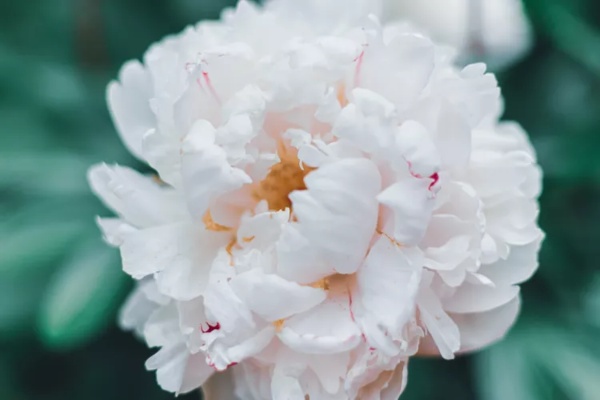I won’t be wrong if I call Peonies the spring-blooming garden stars. They have large, showy blooms, heady aromas, and great personalities. There are nearly 38 species within the genus Paeonia, collectively known as peonies. While most are herbaceous perennials, some are woody shrubs. These flowers are medium-sized and possess tuberous roots that are a combination of thick storage roots and thin roots that are made to absorb water and nutrients. It is essential to carefully handle the roots while planting and replanting, as well as when you’re dividing plants for propagation. Peonies contain paeonal which is a little toxic to dogs, cats, and horses.
Plant Attributes
- Common Name: Peonies
- Botanical Name: Paeonia officinalis
- Plant Type: Herbaceous perennial, or woody shrub
- Mature Size: 2-3 ft. tall, 3-5 ft. wide
- Sun Exposure: Full Sun
- Soil Type: Well-draining
- Soil pH: Slightly acidic
- Bloom Time: Late spring to late summer
- Hardiness Zone: 3-9 (USDA)
- Native Area: Asia, Europe, and Western North America
- Toxicity: Mildly toxic to pets
Also, Read How to Grow and Care for Cordyline Plants in Your Garden
Peony Care
Here are some important requirements for growing a peony plant:
- Keep the plant in a spot that receives six or more hours of good sunlight.
- Plant in a well-drained, slightly acidic soil.
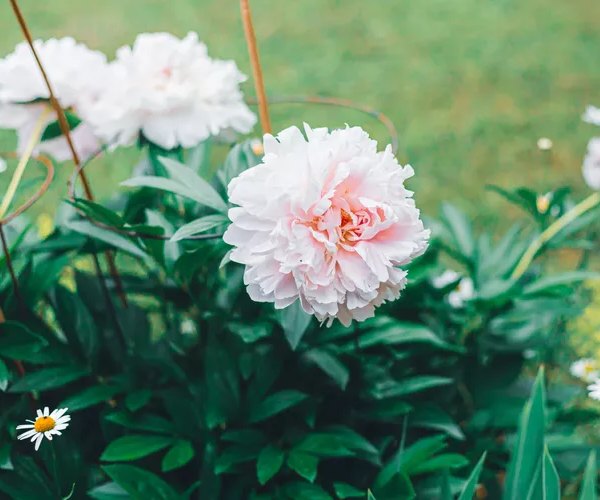
- Water 1 to 2 inches of water weekly.
- Hardy to USDA zones 3 to 9. These plants need a chilling period of around six weeks of temperatures below 40 degrees Fahrenheit in the winter to set spring buds.
- After blooming, add a mix of compost and some fertilizer once a year.
Light
Peonies love full sun. So, they need a location that gets at least six hours of sunlight each day, and a full day of sunlight is even better. If it doesn’t get enough sunlight, you are guaranteed to get fewer blooms and smaller flowers and these plants are susceptible to getting fungal diseases.
Soil
Though very adaptable, peonies like well-drained, and slightly acidic (6.5-7.0 pH). If you are planting it in heavy clay soil, add compost or a soil mix labeled for azaleas and rhododendrons will make it easier for peonies to settle it. Since they can remain in the same spot for upwards of 70 years, you must take time to prepare the soil before planting.
Tree peonies, on the other hand, like a bit more alkaline soil than standard herbaceous peonies, and they do not want to compete with other shrubs.
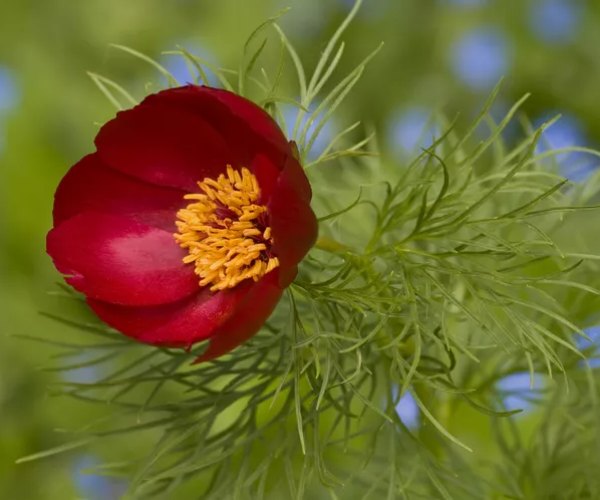
Water
Peonies require moist, well-drained soil to get to their best form. Normally, they should receive a couple of inches of water weekly but are not drought tolerant. Mulching your peonies to help them retain water will decrease the probability of weeds.
Temperature and Humidity
Peonies like cool areas (hardiness zones 3-8) and thrive when they experience cold winters.
Fertilizer
Fertilize lightly. All these peonies need is an annual application of compost mixed with a tiny amount of fertilizer around their base. The correct time to feed the plant with compost and fertilizer is just after they have finished blooming.
Do not mulch peonies in winter. During its first winter, you can gently mulch it with pine needles or shredded bark but mulching is prohibited in spring.
Tree peonies require iron and phosphate and do great when they receive an annual feeding of sulfate and bone meal in spring. Unlike herbaceous peonies, they need regular feeding with a 5-10-5 fertilizer.
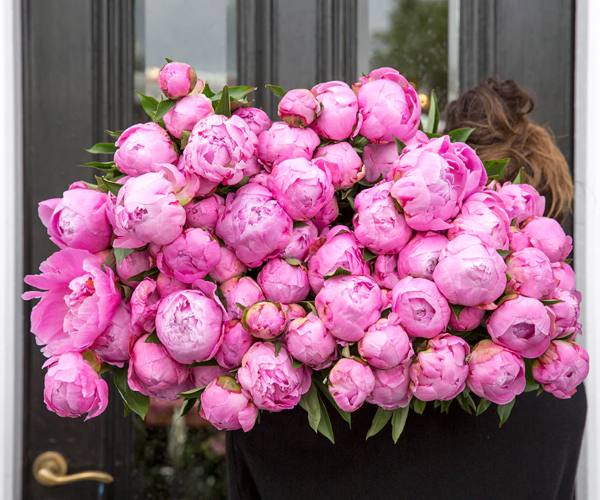
Types of Peonies
- Big Ben: This peony grows magenta flowers, 5 to 6 inches wide, and has a heady aroma. It grows 3 feet tall and wide.
- Festiva Maxima: This variety shows white blooms with specks of magenta, growing 3 feet tall and wide.
- Pillow Talk: This variety boasts giant pink flowerheads with touches of yellow and grows around 2½ feet tall.
- Spider Green: This unique peony has a yellow center and large white, separated petals.
- Sweet Marjorie: This variety grows around 2½ feet tall and presents hearty, dark-pink blooms 5 inches wide.
Pruning
Peonies do not require much pruning. Once yours is done blooming, cut back dead stems and branches and if a stem looks diseased, cut the affected part. If you see two branches rubbing against each other, remove the least desirable one. When you prune peonies, always cut back to right above the first bud.
How to propagate peonies?
The best way to propagate peonies is by lifting and dividing the root clump and immediately replanting the divided pieces. A peony may need this after almost 10 years when it starts losing its vigor and becomes root-bound. Fall is the best time for propagating. You will need a hose and a sharp knife to propagate peonies. Follow these simple steps to propagate peonies.
- Before planning to divide, cut the foliage of the peony back to the ground level.
- After digging the entire plant, remove all soil using a hose.
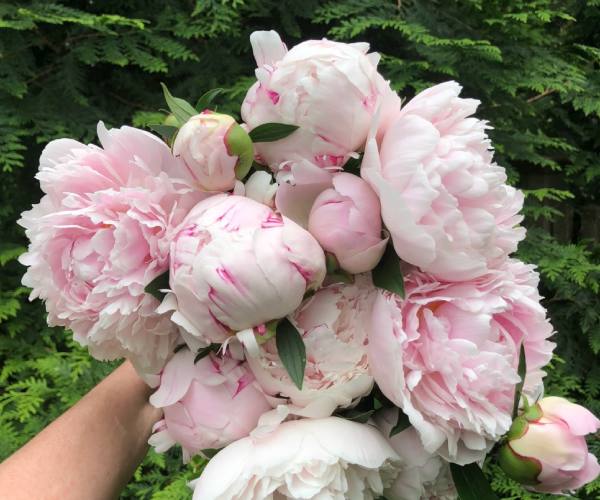
- Using your hands, manipulate the roots into dividable portions, each with three to five “eyes”—small reddish buds that resemble potato eyes—then use a sharp knife to cut the tuberous root clump into divisions.
- Get rid of all the baby roots in each division and leave only the large and fleshy roots.
- Replant the divisions as soon as possible.
Planting and transplanting Peonies
Normally, peonies are purchased as potted plants in ½- or 1-gallon containers at the nursery or as bare roots. They are often packaged with peat moss or wood shavings in plastic bags. The peonies that we get at plant society sales or plant swaps are often from the tuberous bare root.
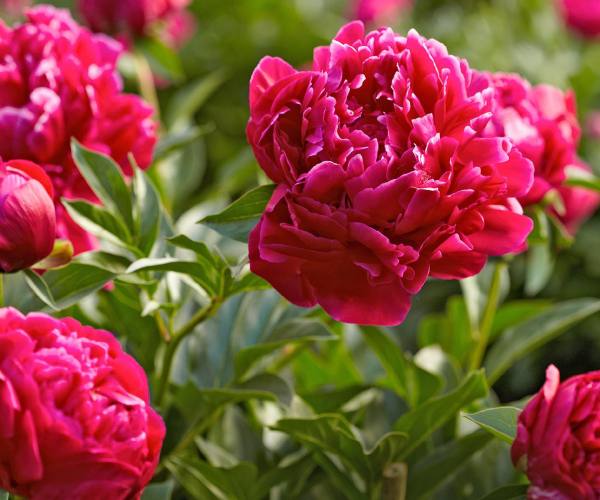
When choosing potted peonies, try looking for healthy specimens that do not have leaf spots or weak stems. When planting from bare tuberous roots, check that the root clump has at least three to five eyes. These eyes will eventually elongate, becoming the plant’s stems. Remember that a mature peony must be at least three to four years old before it is divided into bare roots. While Tuberous clumps with one or two eyes may still grow, they will take longer to become established blooming plants.
Common pests and diseases
Peonies might especially get infested by gray mold. To prevent this, do not plant peonies too close to each other and make sure air circulates between the plants. You can also use copper soap fungicides as well.
Gardeners often find peony blossoms full of ants, which love the nectar secreted by the fragrant flowers. Ants do not harm the plant, they rather act as other floral-feeding insects that might carry disease or otherwise cause damage. However, shake your peonies slightly before bringing them indoors.
How to get peonies to bloom
Bloom months
Typically, peonies bloom in early spring and summer between April and June.
What do peony flowers look and smell like?
Peony flowers can come in a wide range of colors, forms, and scents. Flowers can be 3- to 6-inches in diameter with petals in single, semi-double, or double forms. Bloom colors can be white, pink, rose, red, purple, and coral with a heady fragrance or no detectable scent. Fragrant peonies can smell like roses, spice, citrus, or slightly sweet.
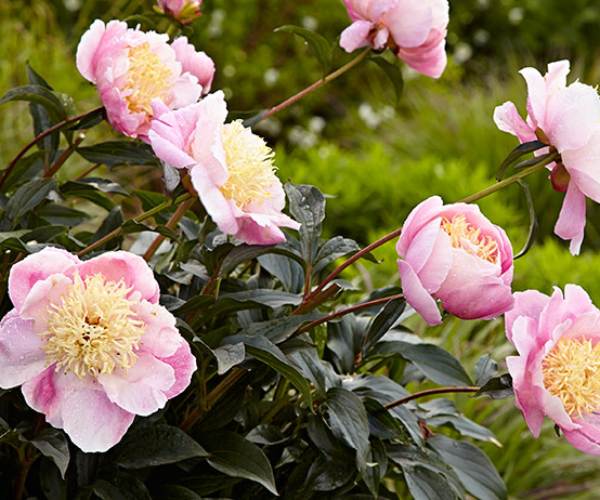
How to encourage more blooms
Make sure your peonies get at least six hours of sunlight a day, are planted no more than 2 to 3 inches deep, and are fed lightly once a year. Lack of sunshine, smothering the roots and eyes, and too much nitrogen can stunt blooming.
FAQs
Q: How long can a peony live?
A: Peonies are classic garden plants that can thrive for decades with minimal care when planted in soil that meets their needs. One of the longest-lived of all garden plants, peonies are sometimes handed down from generation to generation in families. It is important to do the initial planting correctly because peonies can be temperamental about being moved once they are established.
Q: How long does it take for peonies to bloom?
A: The time it takes for a peony to mature and produce its first blooms depends on if you’re planting by seed, bare root, or a nursery plant. Planting by seed can take three to five years for flowers to appear. Bare-root peonies may bloom in the first year, for a larger specimen, or up to three years, if it’s smaller, for healthy roots to establish. Bare-root peonies are better planted in the fall. Nursery plants can bloom in the first year, but younger plants may take as long as two years.
Also, Read What Is a Perennial? How to Choose and Care for Perennial Plants!
